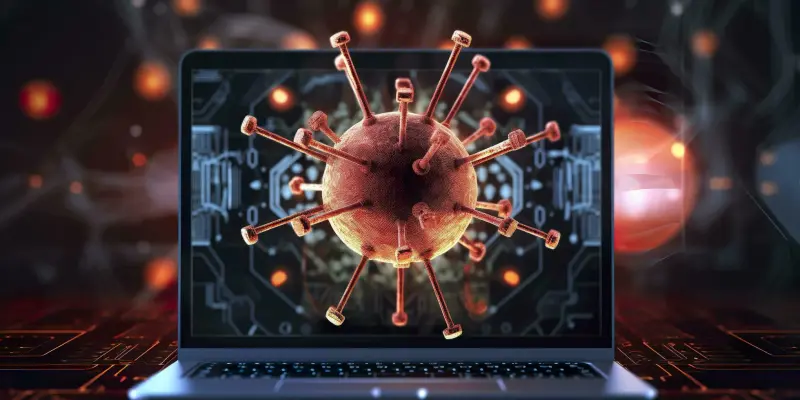The healthcare and pharmaceutical sectors are once again under attack from a newly discovered and advanced remote access Trojan (RAT) known as ResolverRAT. Identified by Morphisec Threat Labs, this latest threat stands out due to its sophisticated in-memory execution and intricate evasion techniques, making it exceptionally challenging for cybersecurity professionals to detect and analyze. Unlike its predecessors, ResolverRAT features a unique loader and payload architecture, even though it shares some reused binaries and phishing infrastructures with older malware campaigns. The malware’s components and deployment methods, however, are largely innovative and original.
Sophisticated Infiltration Techniques
Social Engineering and Localization
ResolverRAT initiates its attack by employing sophisticated social engineering tactics. Employees across various countries have been targeted with carefully crafted phishing emails that often focus on copyright violations or legal inquiries. These malicious emails are tailored to the recipient’s local language and cultural context, suggesting a highly coordinated global operation aimed at maximizing the infection rates.
This method of localization not only increases the likelihood of successful infiltrations but also shows a deeper understanding of different cultures by the threat actors, making the malware campaign even more insidious. Such tailored approaches are particularly effective because they invoke a sense of urgency and legitimacy, tricking unsuspecting users into opening malicious attachments or clicking on deceitful links. Once the malware gains a foothold, it leverages DLL side-loading, using signed but vulnerable executables like hpreader.exe to execute its payload.
Advanced Memory-Resident Payload
Upon successful infiltration, ResolverRAT proceeds to execute a memory-resident payload that exhibits a high level of sophistication. The payload is encrypted using AES-256 and compressed with GZip to evade detection. Several layers of obfuscation, including string obfuscation with numeric IDs and encrypted embedded resources, further cloak its activities. A complex decryption state machine is also employed to alter data and processes dynamically, rendering traditional detection methods ineffective.
The RAT uses reflective DLL loading to inject its malicious code directly into memory, bypassing traditional file system-based security monitoring. This method ensures that the malware can remain active without leaving significant traces on the infected system, thereby avoiding detection by conventional antivirus software. ResolverRAT’s innovative approach to maintaining its presence within a system demonstrates a significant progression in cyber threat methodologies, highlighting the need for advanced security measures addressing memory-based threats.
Persistence and Command and Control
Stealthy Persistence Methods
To maintain its foothold, ResolverRAT employs a series of persistence techniques. These include making registry changes, strategically placing files across user directories, and employing a fallback system that automatically retries alternative methods if initial attempts fail. By using these strategies, the malware ensures that it can re-establish itself even if parts of it are removed or disabled by security measures. This multi-faceted persistence approach significantly increases the challenge for IT teams trying to eradicate the malware. It demonstrates the high technical proficiency of the threat actors behind ResolverRAT. The malware’s persistence mechanisms also involve routine checks and updates to adapt to any changes within the system or new security patches, ensuring it remains embedded and operational over long periods.
Obfuscation and Data Exfiltration
ResolverRAT’s command-and-control (C2) communications showcase sophisticated evasion skills. The malware uses a custom certificate validation process to bypass standard root authorities, ensuring that its communication remains undetected. Additionally, it employs obfuscated IP rotation and custom protocols, mimicking regular network traffic to blend seamlessly within typical operational activities. This level of stealth ensures that communication between the infected system and the C2 server goes unnoticed by many security monitoring tools.
Data exfiltration is conducted through chunked transfers, minimizing the risk of detection. The RAT’s multi-threaded command processing and resilient error handling ensure that the malware continues to operate smoothly even under challenging conditions. These advanced capabilities reflect a well-designed and robust threat architecture that can effectively mimic legitimate system behavior while carrying out malicious activities.
Mitigation and Future Considerations
Recommended Protective Measures
To defend against such sophisticated threats as ResolverRAT, security experts advocate several protective measures. One crucial step is user awareness training focused on identifying and avoiding phishing attempts. Employees should be educated about the risks and signs of social engineering attacks. Deploying behavior-based endpoint protection systems that monitor anomalies in system behavior rather than relying solely on signature-based detection can also offer enhanced security.
Routine audits and reviews of system activities, including memory usage and unauthorized persistence mechanisms, are essential. By detecting unusual memory activity and changes within the system, IT teams can identify potential infiltrations early on. Implementing these security measures can provide better protection against sophisticated attacks that traditional security platforms may not effectively counter.
Addressing Evolving Threats
The healthcare and pharmaceutical industries are once more targeted by a newly discovered, highly advanced remote access Trojan (RAT) called ResolverRAT. Uncovered by Morphisec Threat Labs, this nascent threat is notably distinguished by its sophisticated in-memory execution and complex evasion tactics, making it remarkably difficult for cybersecurity experts to identify and scrutinize. Unlike previous iterations, ResolverRAT is characterized by its distinctive loader and payload architecture, despite having some reused binaries and phishing infrastructures from older malware campaigns. What sets ResolverRAT apart is its largely innovative and original components and deployment methodologies. The intricate design of ResolverRAT signifies an evolution in cyber threats, specifically engineered to infiltrate and compromise sensitive systems discreetly. This development underscores the urgent need for enhanced security measures and constant vigilance in the continually evolving landscape of cybersecurity threats targeting critical sectors.

